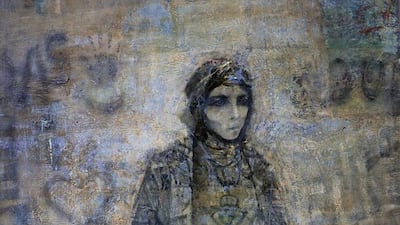The horrors of the massacre of women and children in the Sabra and Shatila refugee camps shown in a lithograph by the Iraqi artist Dia Al Azzawi plays out alongside the French occupation of Algeria and the tragic tale of Mohammed Issiakhem, who lost his left arm in a grenade explosion that also claimed the lives of his nephew and two sisters.
In another area, the migration of early Egyptian artists to Italy is told through oil paintings of canals and the ancient citadel in Rome. Simultaneously, we see the work of Mahmoud Said, who was commissioned in the early 1950s to paint daily life in Upper Egypt.
These are just some of the myriad tales that have been expertly woven within the extensive exhibition of works from Sharjah’s Barjeel Art Foundation and will be on show in Emirates Palace in Abu Dhabi from tomorrow until the end of June.
But even if the viewer doesn’t connect with every small narrative, Suheyla Takesh, the curator, says that as long as they are aware of the general themes, then the show will have been successful.
“As long as visitors pick up on the distinct events and the styles that the artists were using and including in their work, that would achieve the objective of the show, which is to showcase the milestones of the 20th century in Arab art,” she says.
Art unifies
The show is titled Sky Over the East, a reference to the poem Du'aa Al Sharq (Prayer of the East) that was written in 1953 and later put to song during the era of Arab nationalism under Gamal Abdel Nasser's Egyptian presidency and broadcast into every home on Sawt Al Arab radio station.
By choosing this song, Takesh says that she aims to show how one cultural product can unify distinct Arab communities under the umbrella of a shared identity.
“Even though it might have been deliberately designed to unite Arabs for a political agenda, the song has transcended that and has really become a cultural product that relates to Arab identity,” she says.
Working under that banner, Takesh selected 56 works from the extensive Barjeel collection, spanning almost the entire 20th century.
There’s not a single thematic thread running through the exhibition and it isn’t displayed chronologically. Instead, Takesh creates links using subject matter, style or formal composition of work.
Highlights
The show opens with a collection of old Egyptian miniature paintings from the first half of the century when Arab artists were beginning to go to Europe to study. We see work by Youssef Kamel, who went to Rome, and the oldest piece in the show, Mohammed Naghi's Paysage d'Italie from 1914. Also in this section is Adam Henein's bronze sculpture Marie Nilus, which was shown in Barjeel's Arab Modernism exhibition Re: Orient last year.
As well as historical undertones, Takesh is also attempting to show the influence of the style of impressionism on these artists and therefore reveal why Mahmoud Said, for example, should certainly be considered a master alongside his European counterparts.
Later in the show is a series of abstractionists, led by Jafar Islah, a Kuwaiti who, painting in the 1960s, was far ahead of the rest of the region in terms of this style. Adjacent to his work hangs Relief by Chafic Abboud, who uses ceramic on bronze for his abstract work.
“Although the pieces are different, the textures are very similar,” says Takesh, who goes on to point out work by Saliba Douaihy, another abstractionist in this segment who was working out of New York at the time.
“They were not in the same place and often not working at the same time, but there is something within each of the pieces that brings the artists back to their roots,” Takesh continues.
Essence and style
In other areas, she links the pieces by narrative. When the viewer walks on from the haunting Femme et Mur by Mohammed Issiakhem, they're faced with Madonna and Child by Paul Guiragossian and Icons of Moudarres by Fateh Moudarres. On the next wall is an Emirati artist, Mohammed Al Mazrouei, who as a young child witnessed his mother dying in childbirth, and paints wide-eyed faces with pained expressions.
“The idea is try to place them in such a way so that the story links them all,” Takesh says.
The other Emirati artists in the show are more familiar names such as Mohammed Kazem, Hassan Sharif and Najat Makki, but Takesh has selected works not typical to their style.
“My point was to select pieces that were made while they were still searching for their essence and style,” she says, explaining a choice that makes the entire exhibition a pleasure to view.
Hosted by Abu Dhabi Music and Arts Foundation (Admaf), the show is accompanied by a thorough education programme for all ages. Workshops for children, talks and open panel discussions will be held during the month of June, as well as guided tours of the exhibition.
Admaf's founder Hoda Al Khamis-Kanoo says that the exhibition is being hosted in celebration of International Museum Day. "The partnership with Barjeel has formed a creative platform on which leading Arab artists can shine a light on a fascinating aspect of 20th century history," she says. "Sky Over the East highlights our shared objective: to create prominent public platforms that elevate the understanding and appreciation of the visual arts in the UAE and beyond."
• Sky Over the East runs until June 27 at Emirates Palace hotel in Abu Dhabi
aseaman@thenational.ae

